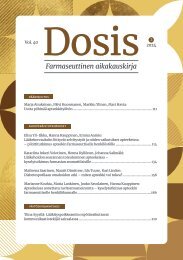Maintworld 1/2020
ROTATING EQUIPMENT SERVICES: A COMPREHENSIVE, WORRY-FREE PACKAGE // SELF-INFLICTED RELIABILITY PROBLEMS OF ROTATING MACHINERY // VIEWING MAINTENANCE AS A SYSTEM TO OPTIMIZE PERFORMANCE
ROTATING EQUIPMENT SERVICES: A COMPREHENSIVE, WORRY-FREE PACKAGE // SELF-INFLICTED RELIABILITY PROBLEMS OF ROTATING MACHINERY // VIEWING MAINTENANCE AS A SYSTEM TO OPTIMIZE PERFORMANCE
Create successful ePaper yourself
Turn your PDF publications into a flip-book with our unique Google optimized e-Paper software.
TECHNOLOGY<br />
Industrial AI in Maintenance:<br />
False Hopes or Real<br />
ACHIEVEMENTS?<br />
Artificial intelligence (AI) is an umbrella term for a set of technologies in which<br />
computer systems are programmed to exhibit complex behaviour in challenging<br />
environments. AI is regarded as the major force driving innovation today.<br />
Authors: UDAY KUMAR, DIEGO GALAR and RAMIN KARIM, Luleå University of Technology<br />
FROM AN INDUSTRIAL point of view, AI technologies should be<br />
understood as methods and procedures that enable technical<br />
systems to perceive their environments through context and<br />
situation awareness. They are able to process what they have<br />
monitored and modelled, solve certain problems, find novel<br />
solutions never found by humans, make decisions, and learn<br />
from experience to be better able to manage the processes and<br />
tasks put under AI supervision, Figure 1.<br />
Machine learning (ML) is one area of artificial intelligence<br />
used by industry. Machines need data to learn, either large<br />
quantities of data for one-time analytical purposes, or streams<br />
of data from which learning is continuously taking place. Based<br />
on acquired data either on line or off line, machine learning<br />
can reduce complexity and detect events or patterns, make<br />
predictions, or enable actions to be taken without explicit programming<br />
in the form of the usual ‘if-then’ routines or without<br />
classic automation and control engineering, Figure 2.<br />
Figure 2:<br />
Roadmap<br />
from<br />
traditional<br />
automated<br />
process to<br />
Industrial AI<br />
Figure 1: Solution and knowledge extraction form asset data<br />
48 maintworld 1/<strong>2020</strong>

















